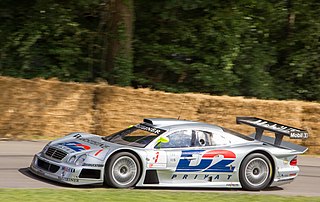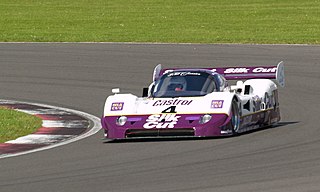
The Porsche 911 GT1 is a car designed and developed by German automobile manufacturer Porsche AG to compete in the GT1 class of sportscar racing, which also required a street-legal version for homologation purposes. The limited-production street-legal version developed as a result was named the 911 GT1 Straßenversion.

Jochen Richard Mass is a German former racing driver and broadcaster, who competed in Formula One from 1973 to 1982. Mass won the 1975 Spanish Grand Prix with McLaren. In endurance racing, Mass won the 24 Hours of Le Mans in 1989 with Sauber.

Mauro Giuseppe Baldi is an Italian former racing driver, who competed in Formula One from 1982 to 1985. In endurance racing, Baldi won the World Sportscar Championship in 1990 with Sauber, and the 24 Hours of Le Mans in 1994 with Porsche; he won the 12 Hours of Sebring in 1998 and is a two-time winner of the 24 Hours of Daytona with Doran.

The Mazda 787 and its derivative 787B are Group C sports prototype racing cars that were developed by Japanese automobile manufacturer Mazda for use in the World Sportscar Championship, All Japan Sports Prototype Championship, and the 24 Hours of Le Mans from 1990 to 1991. Designed to combine a mixture of the Fédération Internationale du Sport Automobile (FISA) Group C regulations with the International Motor Sports Association (IMSA) GTP regulations, the 787s were the last Wankel rotary-powered racing cars to compete in the World and Japanese championships, using Mazda's R26B engine.

The 24 Hours of Le Mans is an endurance-focused sports car race held annually near the town of Le Mans, France. It is widely considered to be one of the world's most prestigious races, and is one of the races—along with the Monaco Grand Prix and Indianapolis 500—that form the Triple Crown of Motorsport, and is also one of the races alongside the 24 Hours of Daytona and 12 Hours of Sebring that make up the informal Triple Crown of endurance racing. Run since 1923, it is the oldest active endurance racing event in the world.

Judd is a brand of racing car engines built by Engine Developments Ltd., a company founded in 1971 by John Judd and Jack Brabham in Rugby, Warwickshire, England. Engine Developments was intended to build engines for Brabham's racing efforts, and became one of the first firms authorised by Cosworth to maintain and rebuild its DFV engines, but has since expanded into various areas of motorsport.

The Jaguar XJR-9 is a sports-prototype race car built by Jaguar for both FIA Group C and IMSA Camel GTP racing. In 1988, Jaguar's XJR-9 won the 24 Hours of Le Mans, after debuting that year at the 24 Hours of Daytona.

The 1991 24 Hours of Le Mans was the 59th Grand Prix of Endurance, taking place at the Circuit de la Sarthe, France, on the 22 and 23 June 1991. It was also the fourth round of the 1991 FIA Sportscar World Championship season.

The 1989 24 Hours of Le Mans was the 57th Grand Prix of Endurance, taking place at the Circuit de la Sarthe, France, on the 10 and 11 June 1989. This year it was not included as a round of the 1989 World Sports-Prototype Championship. The entry list promised a strong contest between five manufacturers. Jaguar had won in 1988 and went on to win the championship; while Sauber had finished second and was now matching Jaguar on the track. New regulations were coming in 1991, and the first examples of the 3.5-litre normally-aspirated formula were entered by Spice Engineering.

The 1988 24 Hours of Le Mans was the 56th Grand Prix of Endurance as well as the fifth round of the 1988 World Sports-Prototype Championship. It took place at the Circuit de la Sarthe, France, on the 11 and 12 June 1988. At their third attempt, Jaguar arrived with five cars to take on the strong Porsche works team of three cars, in their only race for the Championship season. The other potential rival was Sauber, now formally backed by Mercedes-Benz, but after a major high-speed tyre-blowout in practice, their two-car team was withdrawn.

The Mercedes-Benz CLK GTR is a GT1 sports car built and produced by Mercedes-Benz in conjunction with their then motorsport partner AMG. Intended for racing in the new FIA GT Championship series in 1997, the CLK GTR was designed primarily as a race car. As such, the production of road cars necessary in order to meet homologation standards of GT1 was a secondary consideration in the car's design, i.e. the CLK GTR was a homologation special.

Max Welti is a former Swiss racing driver, Sauber's first team manager and thus double winner of the 24 Hours of Le Mans as well as two-time sports car world champion with Sauber Mercedes. Five years later, he wins the 24 Hours of Le Mans for a second time with Porsche as the responsible race director. He then returns to Sauber as overall manager of the Sauber Formula One operation. In 2000 Welti becomes CEO of the European silhouette touring car racing series "V8STAR" before becoming team owner of A1 A1 Team Switzerland in 2005. As an international motorsport strategist and consultant, Welti nowadays works for OEMs, promoters and organisers.

The Mercedes-Benz C11 is a Group C prototype race car introduced for the 1990 World Sports-Prototype Championship. Built by Sauber as a successor to the Sauber C9, the C11 used the same Mercedes-Benz M119 5.0L twin turbo V8. It was the first time that Mercedes-Benz chose to put their name on the car, instead of simply using Sauber.
The Supercup was a West German auto racing series created by the ADAC in 1986 as a replacement for the Deutsche Rennsport Meisterschaft (DRM). The series used Group C category sports prototypes identical to the ones used in the World Sportscar Championship, yet running nearly exclusively within West Germany. The series lasted for four years before it was cancelled following the 1989 championship.

The Mercedes-Benz C291 was a sports-prototype racing car introduced for the 1991 World Sportscar Championship season. It was Mercedes-Benz’ final car in the Group C category.

The Sauber C8 was a Group C prototype race car introduced in 1985 for the 24 Hours of Le Mans as the first in a partnership between Sauber and Mercedes-Benz.
Throughout its long history, Mercedes-Benz has been involved in a range of successful motorsport activities, including sportscar racing, touring car racing, Grand Prix racing, and rallying. It is currently active in GT racing, and Formula One. Mercedes is also one of only three constructors to complete the Triple Crown of Motorsport, a feat that Mercedes achieved as both a chassis manufacturer and an engine manufacturer by winning the 1952 24 Hours of Le Mans.

The Jaguar XJR-11 was a sports-prototype racing car introduced for the 1989 World Sports Prototype Championship, while its sister car the XJR-10 was introduced to compete in IMSA series races.

The Nissan R90C was a platform used for Group C racing cars built in 1990 by Nissan Motors for competition in World Sportscar Championship (WSC) based in Europe and the All Japan Sports Prototype Championship (JSPC). The cars based on the basic R90C platform would compete until 1993 before Nissan chose to withdraw from sports car racing, not returning until 1997. It won three JSPC championships and several significant endurance races during its career.

The Veskanda C1 is a one-off, Australian designed and built, mid-engined closed top racing car built in 1985 to CAMS Group A Sports Car specifications. Powered by a Chevrolet V8 engine, the car is generally regarded as the fastest sports car ever built in Australia and as of 2016 remains one of Australia's fastest race cars.























